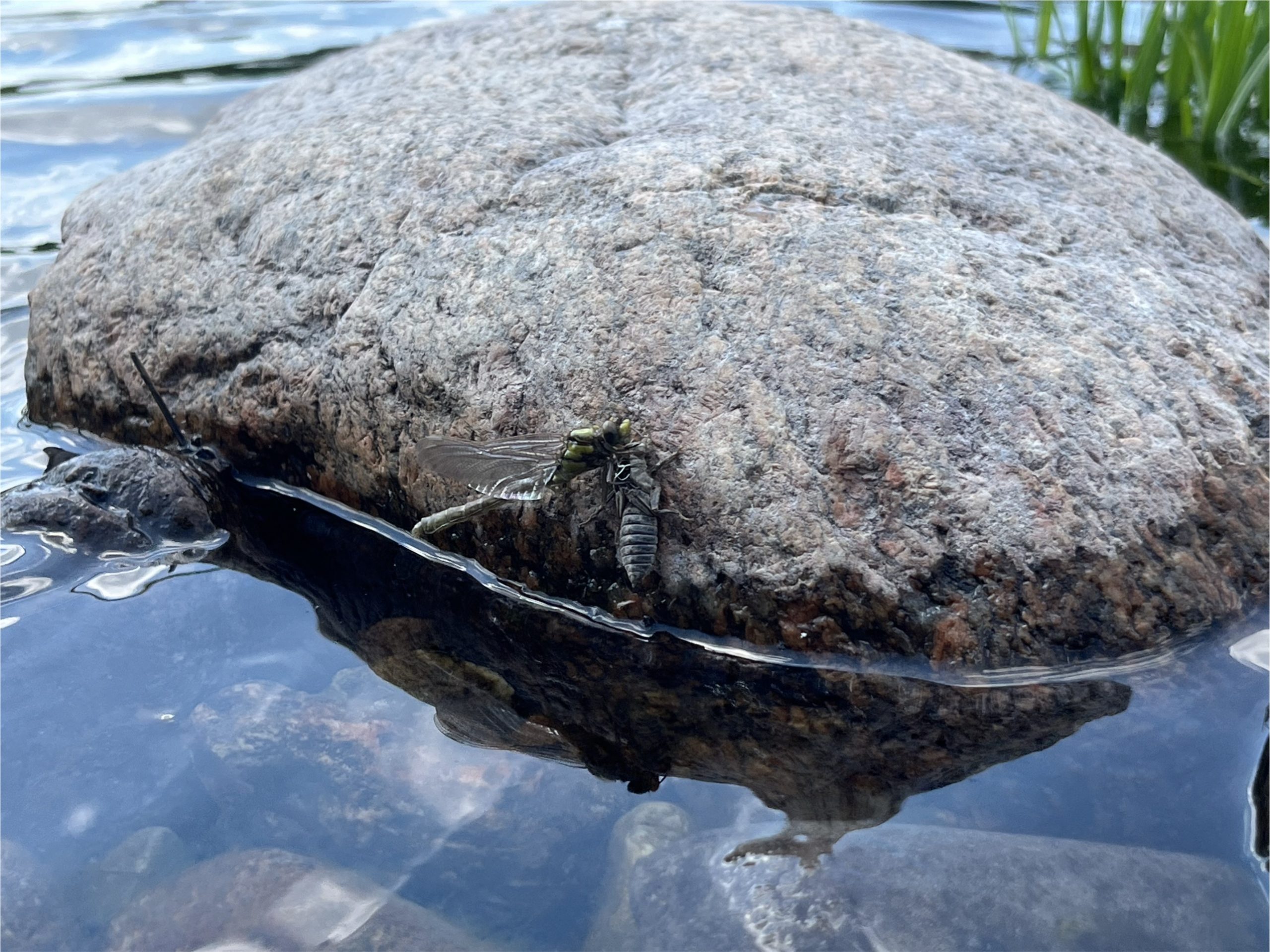
Subscribe & stay up-to-date with ASF

Everyone is in full swing. Whether it’s anglers catching some early bright salmon returning to our rivers, or the different watershed and conservation groups working on projects.
This has been a big week, particularly for ASF’s Wild Salmon Watersheds and Headwaters programs.
“It’s hard to say what is our busiest time of year, but the schools are going out, field crews are getting started, we’re trying to get temperature probes and stuff out in the water, so spring is certainly for research,” said Kris Hunter, the Regional Director for Wild Salmon Watersheds. “It’s where all of our winter planning now comes into play. It’s maybe not our busiest time, but if not, it’s damn close.”
Both Wild Salmon Watersheds and Headwaters work closely with local organizations, but with different approaches. Wild Salmon Watersheds tries to be proactive, and work with the salmon populations that are still relatively healthy.
“To make sure the plans and skills and information is in place to make sure salmon can live and thrive,” Kris said. “But not just salmon — communities and ecosystems, for 100+ years, seven generations.”
After years of successful conservation work in Maine, the Headwaters program expanded to Canada two years ago. It now provides $50,000 per year to projects in each of the five Canadian provinces. It also provides a variety of support to these projects. It is focused specifically on two key aspects of salmon habitat: cold water and connectivity
“It’s a way to kind of really invest in conservation, and building off of what we know and do best, which is cold water refuge and fish passage,” Kris said.
In this edition of Rivernotes, there are reports from the start of some Wild Salmon Watershed and Headwaters projects in PEI and New Brunswick. There is also information on some really fascinating research projects in Nova Scotia, as well as projects from ASF’s own research team. We also have a report from the Rock | Plastic | Salmon film tour in Newfoundland and Labrador. On top of all that, we have river and angling reports from throughout Atlantic Canada and Maine, and even a couple great photo submissions. Please keep the submissions coming!
Kim Thompson, ASF’s Program Director in Newfoundland and Labrador has been busy with an opening tour of a documentary film produced in collaboration with ASF exposing the aquaculture industry’s neglect for the environment in Newfoundland and Labrador. She writes:
“Rolling out this week is the new documentary, Rock | Plastic | Salmon. The film producers Josh and Emily Murphy tell a compelling story of salmon farming in Newfoundland and Labrador and the people trying to protect the coastline from aggressive industry expansion.
‘We hope the film will change people’s minds about salmon farming and encourage leaders in the province to reconsider rewarding companies responsible for the pollution with access to even more public water,’ said Josh Murphy. ‘People want to be heard and they’re asking for balance.’
The film was shown in the welcoming community of Burgeo to a packed house on Monday evening and then in picturesque Ramea Island to an inquisitive group on Tuesday evening. At both locations, following the showing, there was a question-and-answer period hosted by ASF’s conservation campaign director Andrew Clarke.
Reactions from audiences thus far included puzzling questions like, ‘Why is this even allowed to happen?’ ‘Why isn’t industry being charged for their environmental mess?’ There is overwhelming consensus that Rock | Plastic | Salmon needs to be seen by everyone in the province, so they can see how salmon farming companies are mistreating our coastal environment.
June Hiscock from Burgeo commented, ‘We harvest the most special food in the world that comes from the ocean and look at what they’re doing to it. All the companies should stop lying to us when they tell us they’re environmentally friendly, when obviously they’re not.’
As ASF program director for NL, reflecting on the launch of Rock | Plastic | Salmon and its story, it is interesting to hear comments from those in favour of the salmon farming industry and its industry leaders, who say that ASF is a ‘come-from-away’ association with little insight into what is happening on the ground. However, what has been voiced by the communities and their leaders over the course of the last couple of days is just the opposite. As a native Newfoundlander and Labradorian, I strongly feel the need for the people to be heard.”

Screenings continue this week in Woody Point, Corner Brook, and on June 25th in St. John’s. To view the trailer and learn more about the upcoming screenings and to register for an event visit www.rockplasticsalmon.com.
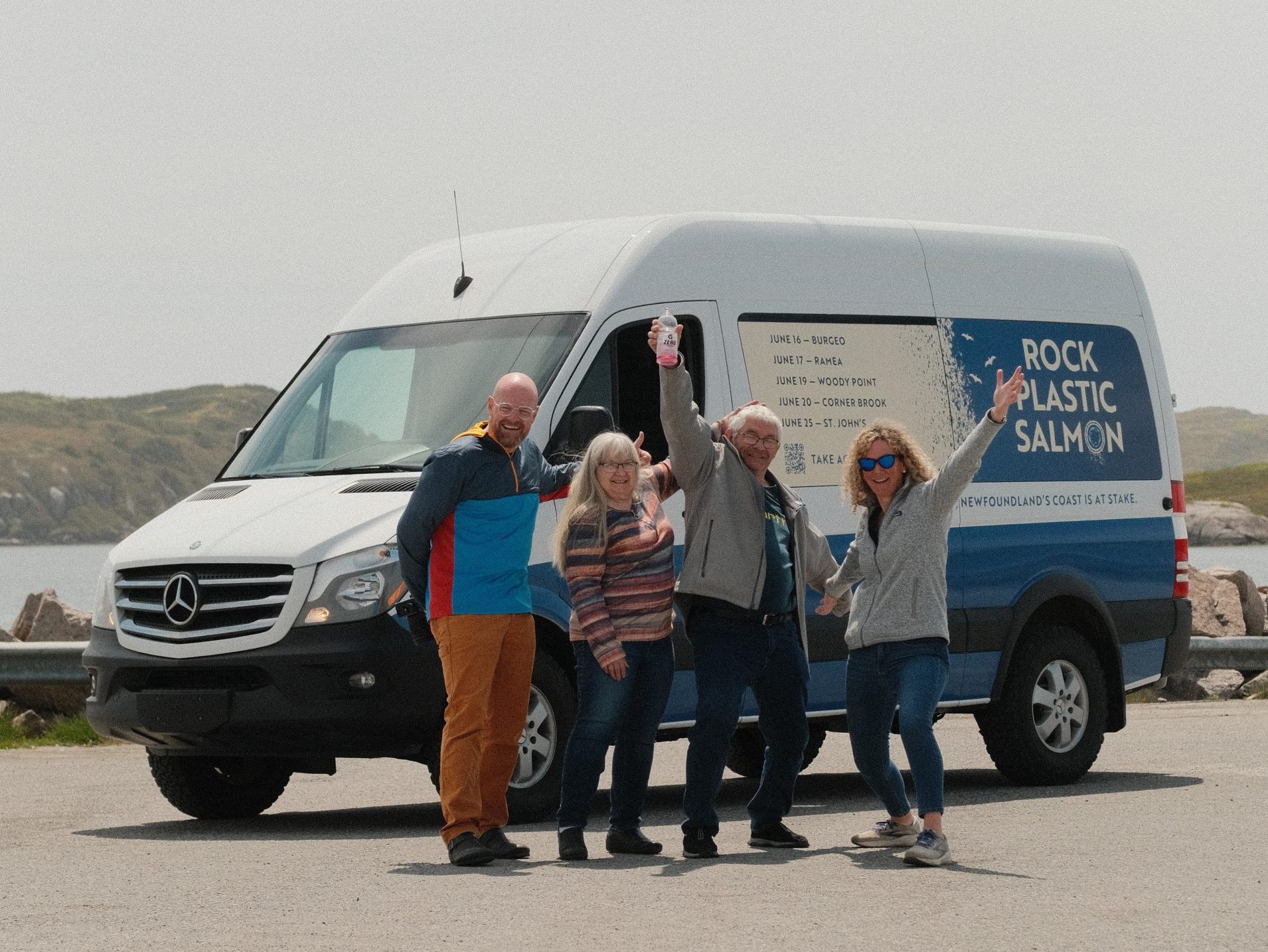
Dave Hennessey, President of the Salmonid Association of Eastern Newfoundland (SAEN) and friends were fishing last week in the Bay St. George area and sent us the following report:
“The fishing itself went from very slow to sporadic to not too bad. The conditions were great for the fish. When we arrived in Bay St. George for a week, we had some very badly needed heavy rains overnight. All the rivers swelled up by the next evening. Some were on bust. So, we didn’t see many fish but just hoped that many were going through. In a couple of days, it went down to high normal and then rain again, and high again. All good. Water temps from 11 to 14C. There were pockets of success. We did not experience really good fishing on any of the five rivers in the Bay St. George area. We hope that changes with more returning adult salmon as the season goes on.”
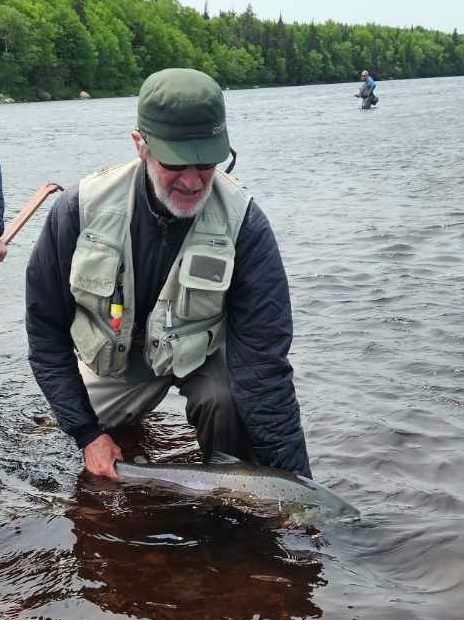
On PEI, ASF has been involved with a lot of great watershed groups working on problem areas for salmon. ASF’s Program Director for Prince Edward Island, Kris Hunter, also worked on projects with other groups, including preparations for the first Riverwatcher system on the East Coast. Kris writes:
“This past weekend Jordan Condon (ASF’s science coordinator for Wild Salmon Watersheds) and I attended Riverbank Heritage Day in Stanley Bridge, hosted by the Trout River Environmental Committee and Carr’s Wildlife Centre. Those attending the annual event were treated to live music, some great interactive exhibits, and got to meet lots of environmental and watershed organizations and hear about their great conservation work.
Jordan and I gave a short presentation on ASF, Headwaters Canada, Wild Salmon Watersheds, and salmon conservation work on PEI.
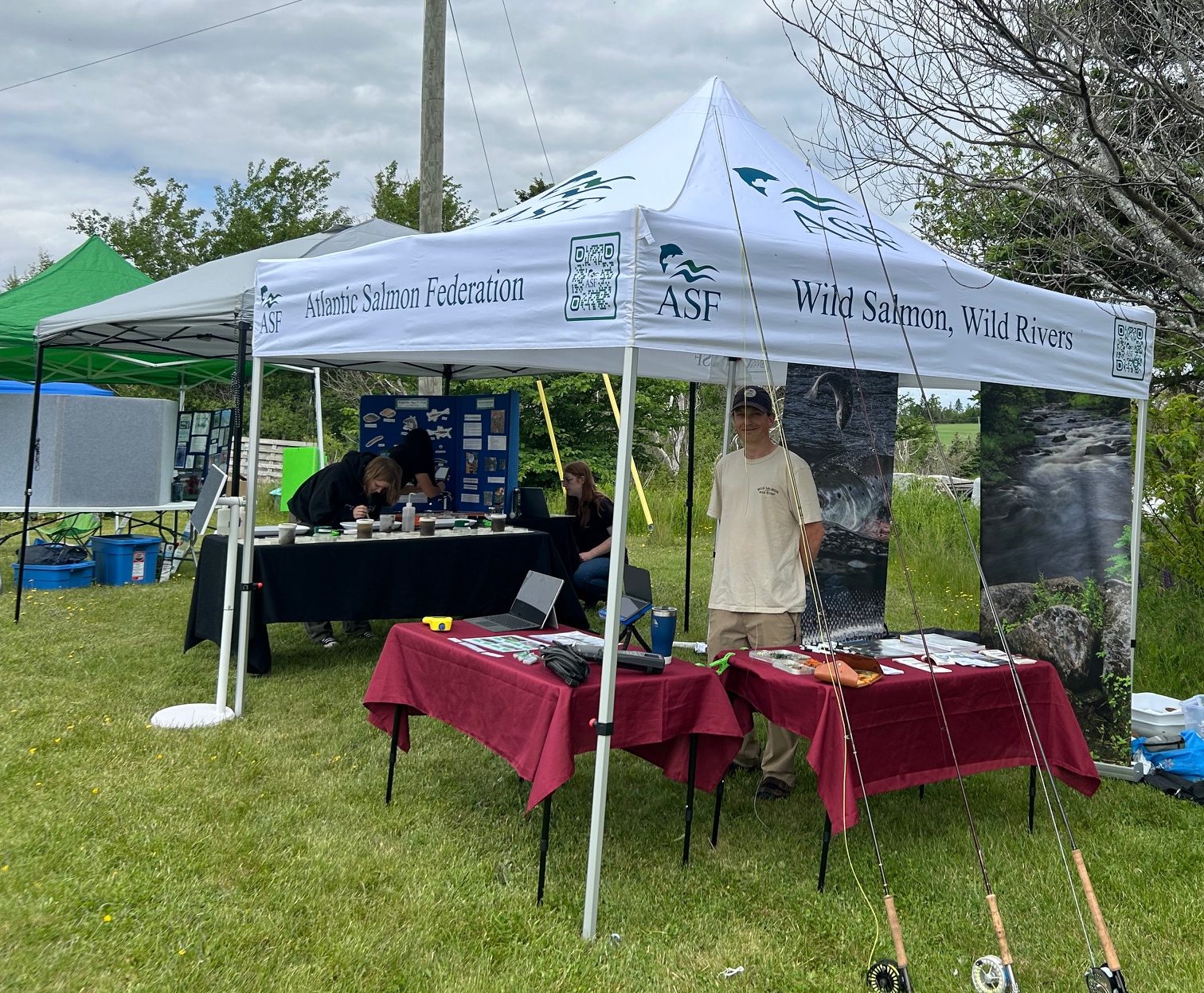
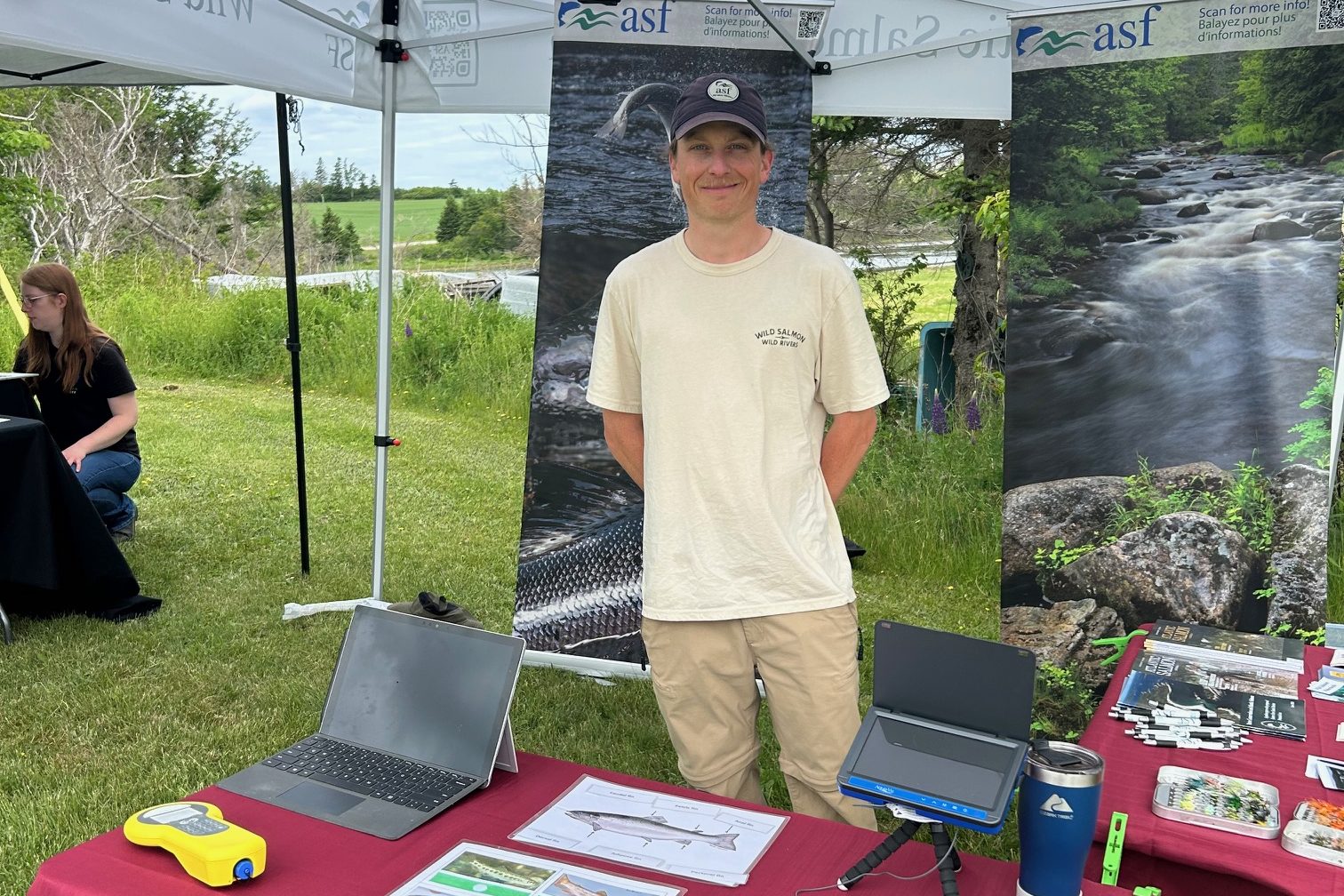
Kris continues:
“Speaking of Headwaters Canada, this week, I will be going out with several PEI groups that will be conducting projects with assistance from our Headwaters program.
Early in the week I looked at three problematic culverts on the Miminegash River with Danny Murphy of Roseville/Miminegash Watersheds and Karalee McAskill form PEI Forest, Fish, and Wildlife. These culverts are being considered for replacement because they are starting to fail, are a barrier to fish passage, and are causing warm water issues. At one of the sites, we were surprised to find an almost 6.5 degree increase in water temperature from a few hundred feet above the impoundment to below the culvert. “
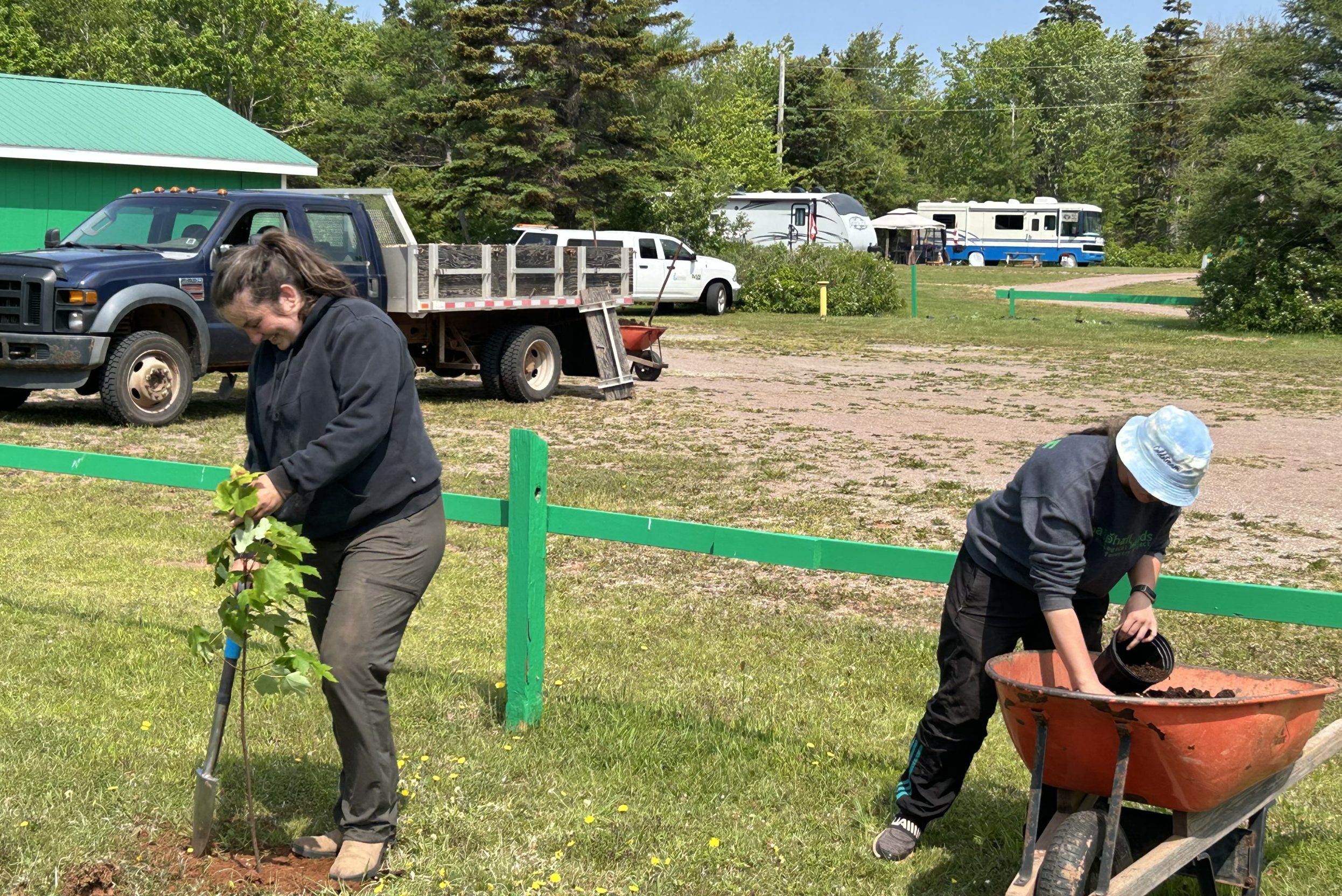
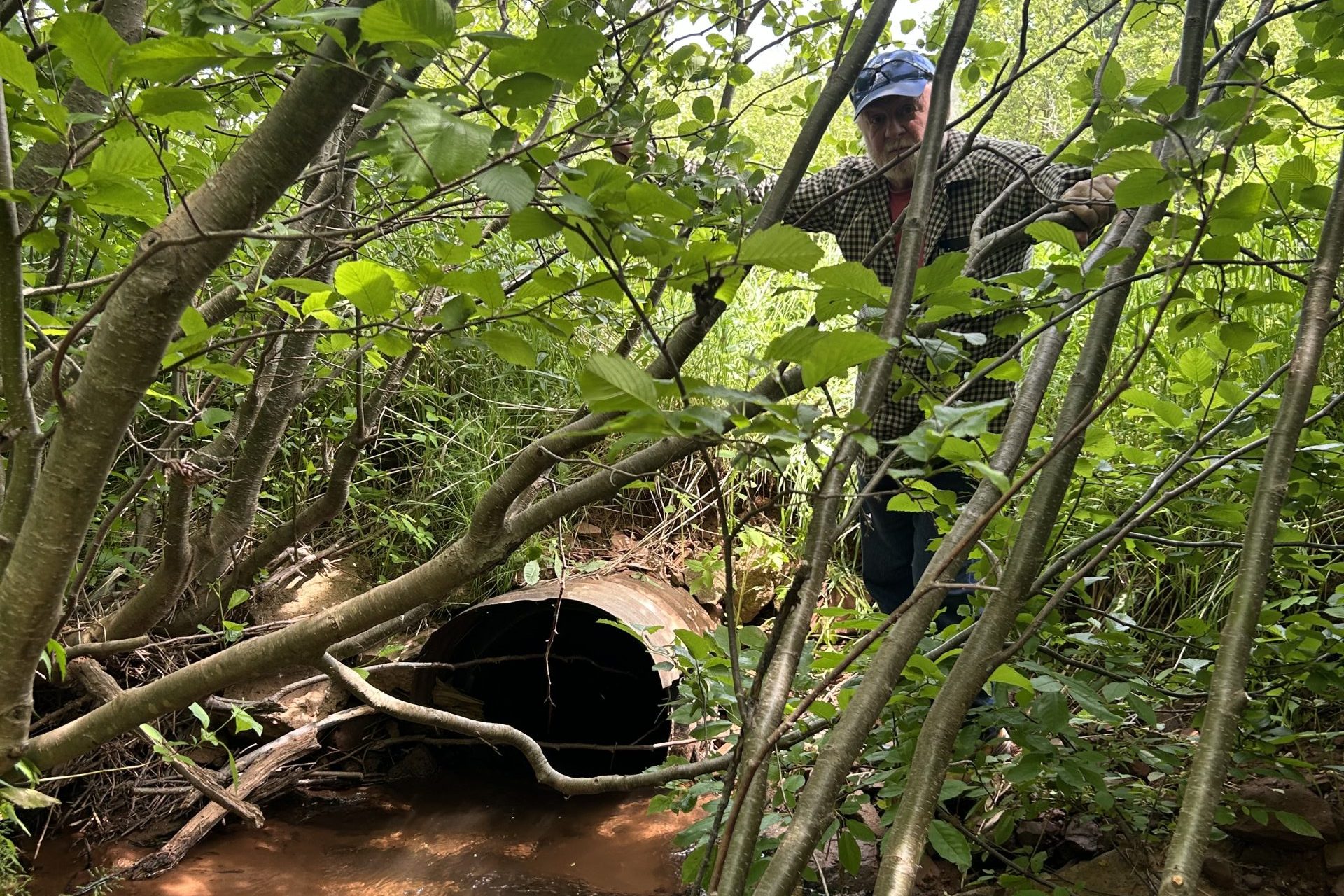
Kris concludes:
“Later in the week I went out with Cascumpec Bay Watershed Association and Cornwall and Area Watershed Group to look for salmon activity and evaluate other problematic crossings.
I rounded out the week working on a salmon assessment project with the PEI Watershed Alliance and Central Queens Branch of the PEI Wildlife Federation that will use a floating resistance weir fence and Riverwatcher system (a fish counting system involving an array of sensors, lasers, and video). This is an exciting step as the floating fences are still relatively new and the Riverwatcher system has never been deployed on the East Coast. This is also a great learning opportunity for us as ASF will be deploying a Riverwatcher system in NL in the near future. More to come on that soon. “
New Brunswick Program Director David Roth is traveling along the Restigouche River and its tributaries, visiting several camps and affiliates before attending this year’s installation of the barrier fence on the Upsalquitch River, organized by the Restigouche River Watershed Management Council. David writes:
“A mandatory stop on this trip was to visit former ASF New Brunswick Program Director Serge Colin, who is now the general manager at Larry’s Gulch. Serge gave me a tour, shared the history of the lodge, and gave an update on the start of the angling season and the latest catch reports from successful guests returning from their morning fishing trips.
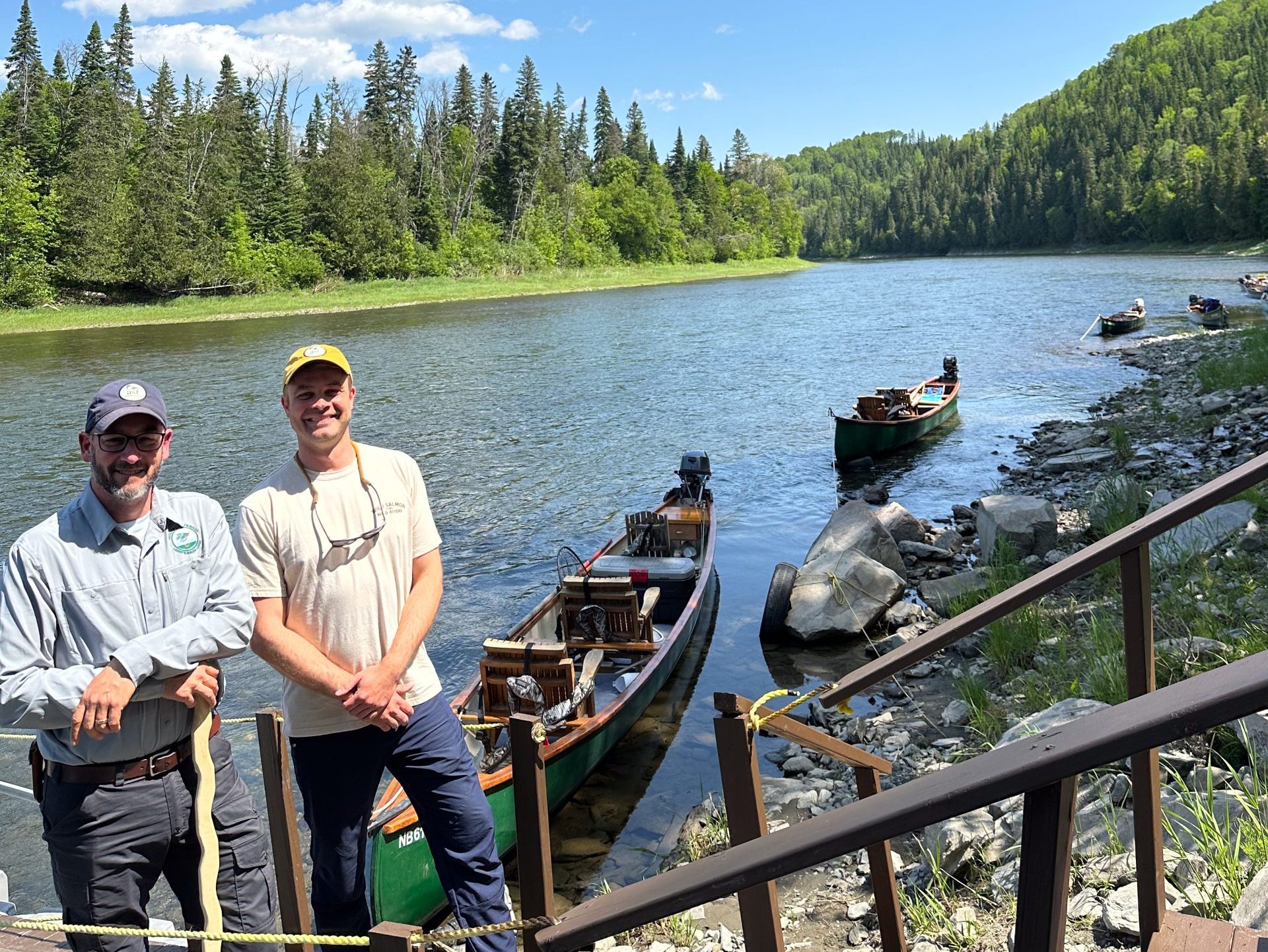
David continued on to the Upsalquitch:
“On the Upsalquitch, I was accompanied by Wild Salmon Watersheds Science Coordinator Jordan Condon to gain hands-on experience with the installation of a specific type of fence and to benefit from the knowledge the group has accumulated over the past five seasons operating it.
Jean-Daniel and his team from the Restigouche River Watershed Management Council install and maintain the fence throughout the season for the Department of Natural Resources. The fence functions similarly to the barrier fences in the headwaters of the Miramichi, protecting fish from poaching. The fish hold in a large pool downstream of the barrier, where guardians are posted 24/7 to look over the site. The fence is removed in autumn when spawning season begins.
ASF is involved in several projects where this type of fence could be advantageous, particularly for creating a narrowing in specific river sections, to deploy RiverWatcher units or antenna arrays across a reduced cross-section of the river. Unlike traditional fences, a floating fence can operate during high water events, providing better data on fish migration and being less susceptible to damage from large debris. Additionally, a significant benefit of this flexible fence system is that canoe parties traveling down the river can glide over it, making it safer and more convenient, compared to the old rigid fence systems. We extend our gratitude to Jean-Daniel and his team for their efforts and taking the time to host us for the day.”
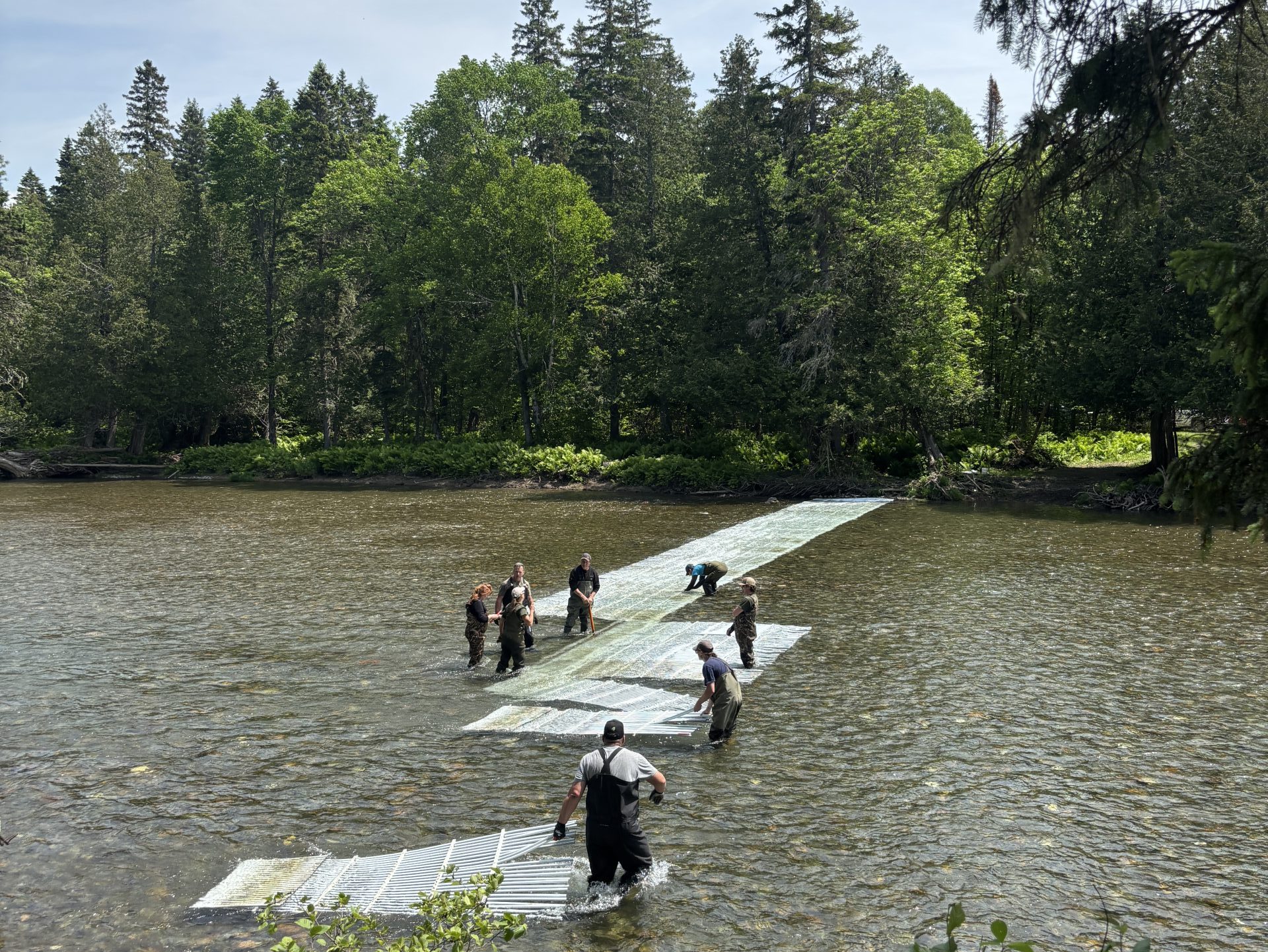
After work, David took advantage of a daily Crown Reserve stretch further down the river to cast his line for bright salmon. Although he did not spot any salmon on the Berry Brook stretch, fishing on the Upsalquitch always brings back fond memories for David, as it was on this river that he caught his first Canadian Atlantic salmon many years ago.
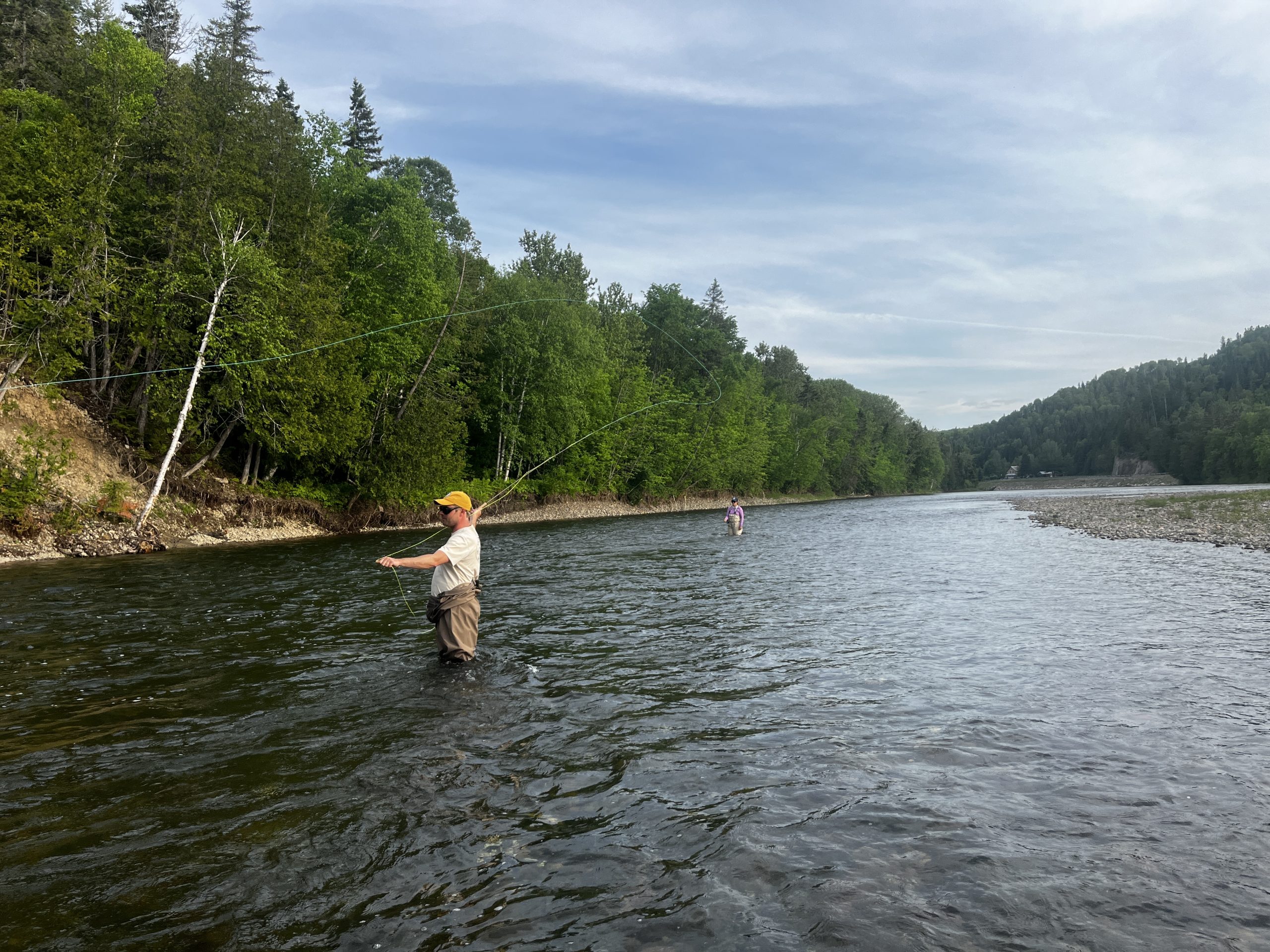
This week we also have a photo submission from John Berryman on the Upper Kedgwick River.
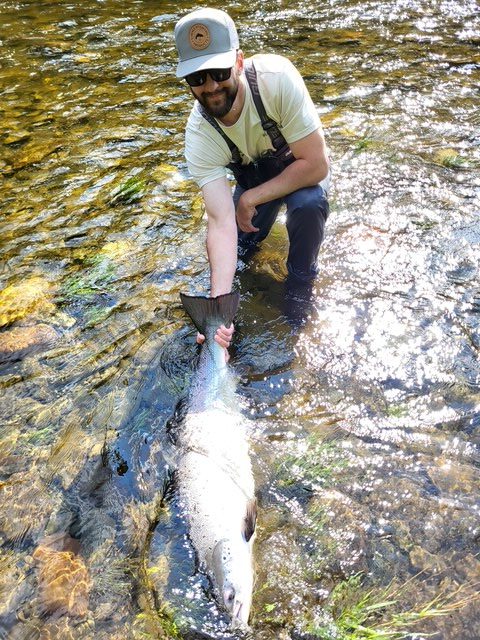
In Maine the fishways continue to provide a great glimpse into the progress of rivers throughout the year. One counted its first salmon of the year this past week. Others show direct correlations between fish activity and water flow and temperature changes.
Colby W. B. Bruchs, a Fisheries Scientist at the Maine Department of Marine Resources, provides an update on the fishway on the Narraguagus River:
“No new salmon this week. We captured 18 American shad. Discharge is around 200 cubic feet per second and the river temperature is steady around 19℃. Low water means salmon ascending the river will need to use the fishway for the time being. Maybe next week!”
On the Penobscot river, Jason Valliere a Marine Scientist with the Maine Department of Marine Resources, writes:
“The river herring run is pretty much over for the year here on the Penobscot river… just a few hundred fish trickling through a day… We had 300-500 shad and a bunch of sea lamprey to keep us entertained during the day:-)
River temperatures have remained cool, at least cooler at this time than the past few years… which is good. Salmon seem to be coming in a little slower than the past few years… hopefully just because the river temperature is cooler and they aren’t feeling the push to hurry it up!
Milford Lift came online in 2014. We are still ahead of 2014,15,16,18,19, and 2021, to date. Hopefully good numbers of fish start showing up soon!
Until next week!”
Jennifer Noll, Marine Resource Scientist with the Maine Department of Marine Resources, has updates from the Kennebec River:
“Finally there has been some reprieve from the cool, wet weather—this past week has overall been warm and dry with some cool evenings. Flow conditions in the lower Kennebec River have been quite steady after June 11th, hovering around a river discharge of 5,500 cfs since June 10th. The low discharge for the week dipped to 5,210 cfs and the high peaked at 14,000 cfs on June 3rd. Currently the river flow is at 5,290 cfs, which falls between the 25% percentile discharge level (4,010 cfs) and the median of 6,910 cfs (https://waterdata.usgs.gov, based on 39 years of data).
Lockwood fish lift, located in Waterville, ME at the first dam on the mainstem Kennebec River, opened on May 1st for the 2025 season. The trap has been operational the entire week. Twenty-nine new Atlantic salmon have been captured to date; the first two arrived on 5/30. We’ve had a few special appearances so far this year: one wild female, three sea-winter (89cm) on 6/8, and one wild female long absence repeat spawner (84.5cm) on 6/11. The water temperature remains cool at 17°C.
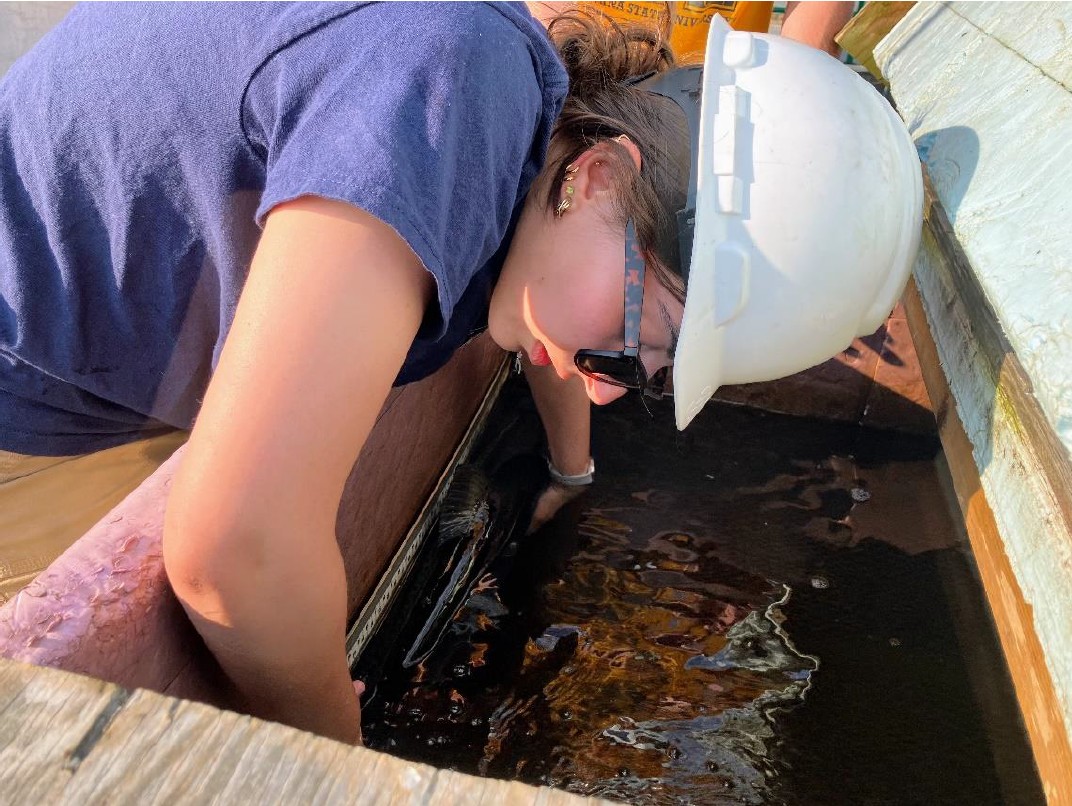
Jennifer also provided updates from the Androscoggin River:
“Brunswick fishway, located in Brunswick, ME on the mainstem Androscoggin River, was opened May 1st this year. Flow conditions in the lower Androscoggin River reached a low river discharge of 3,880 cfs on June 16th and peaked at 8,860 cfs on June 10th. Currently, the river flow is at 4,000 cfs, which falls between the 25% percentile discharge level (3,540 cfs) and the median of 4,560 cfs (https://waterdata.usgs.gov, based on 96 years of data). The temperature is currently ranging between 17.5°C and 19.4°C. The first Atlantic salmon at Brunswick in 2025 showed up on 6/12.”
From Quebec this week, we have three great photo submissions. A close up of a bright salmon tail, a photo by Dan Greenberg of Chantal Morin with a salmon, and a photo from Denis Laberge of Madeleine River.
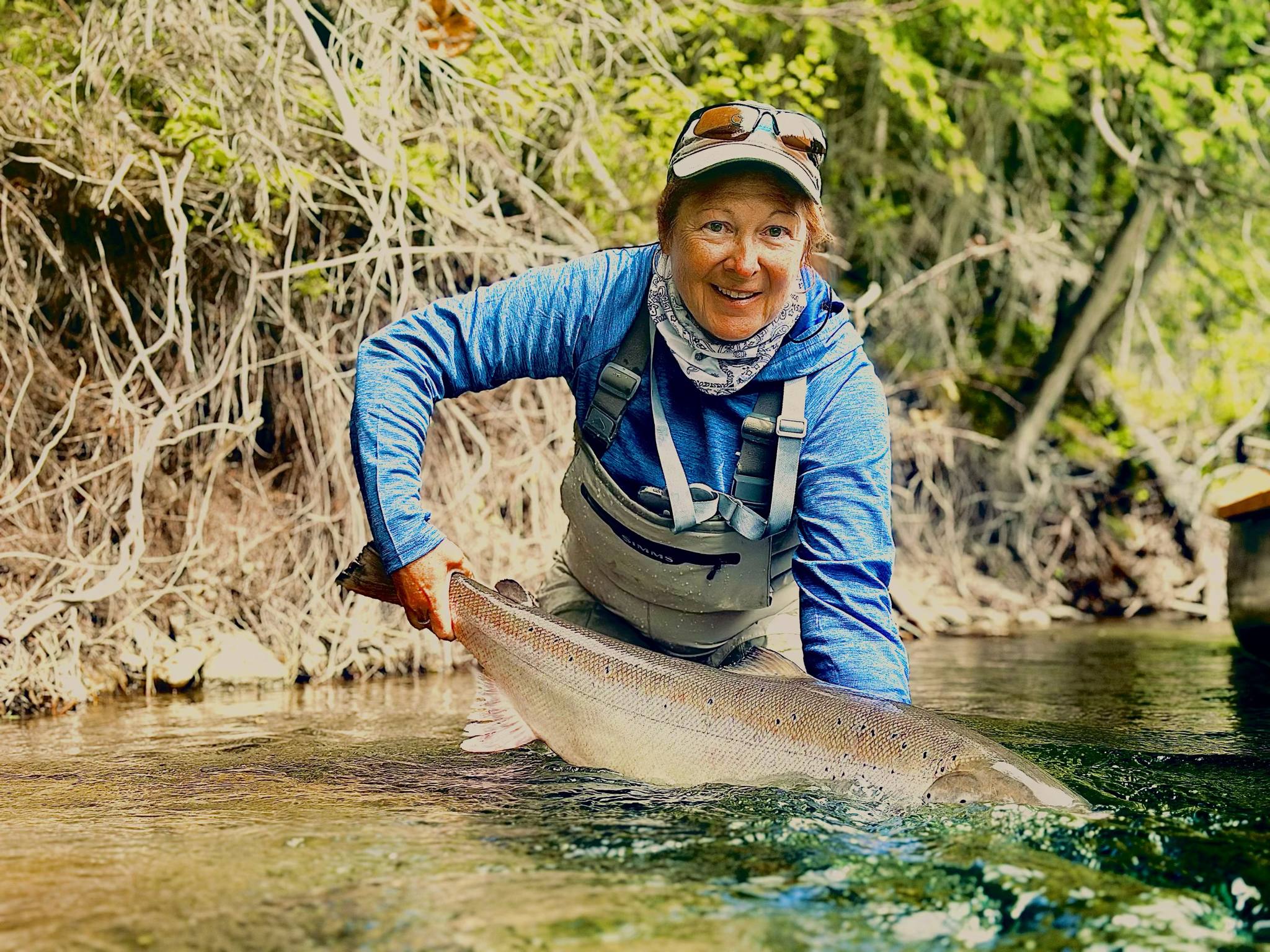
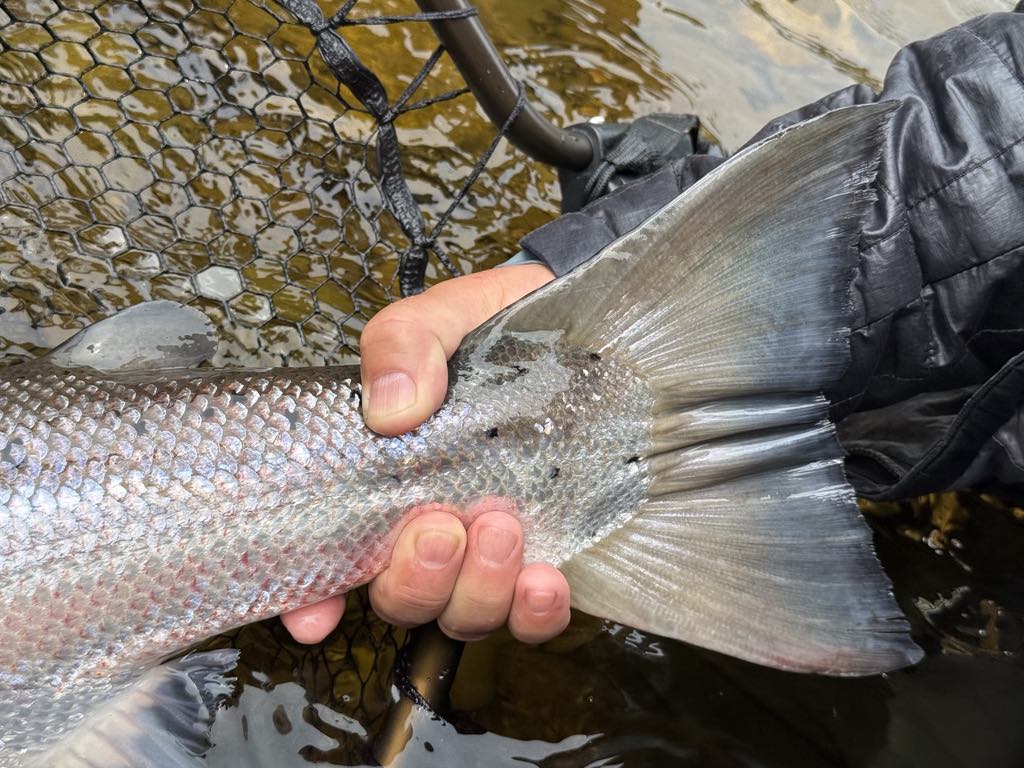
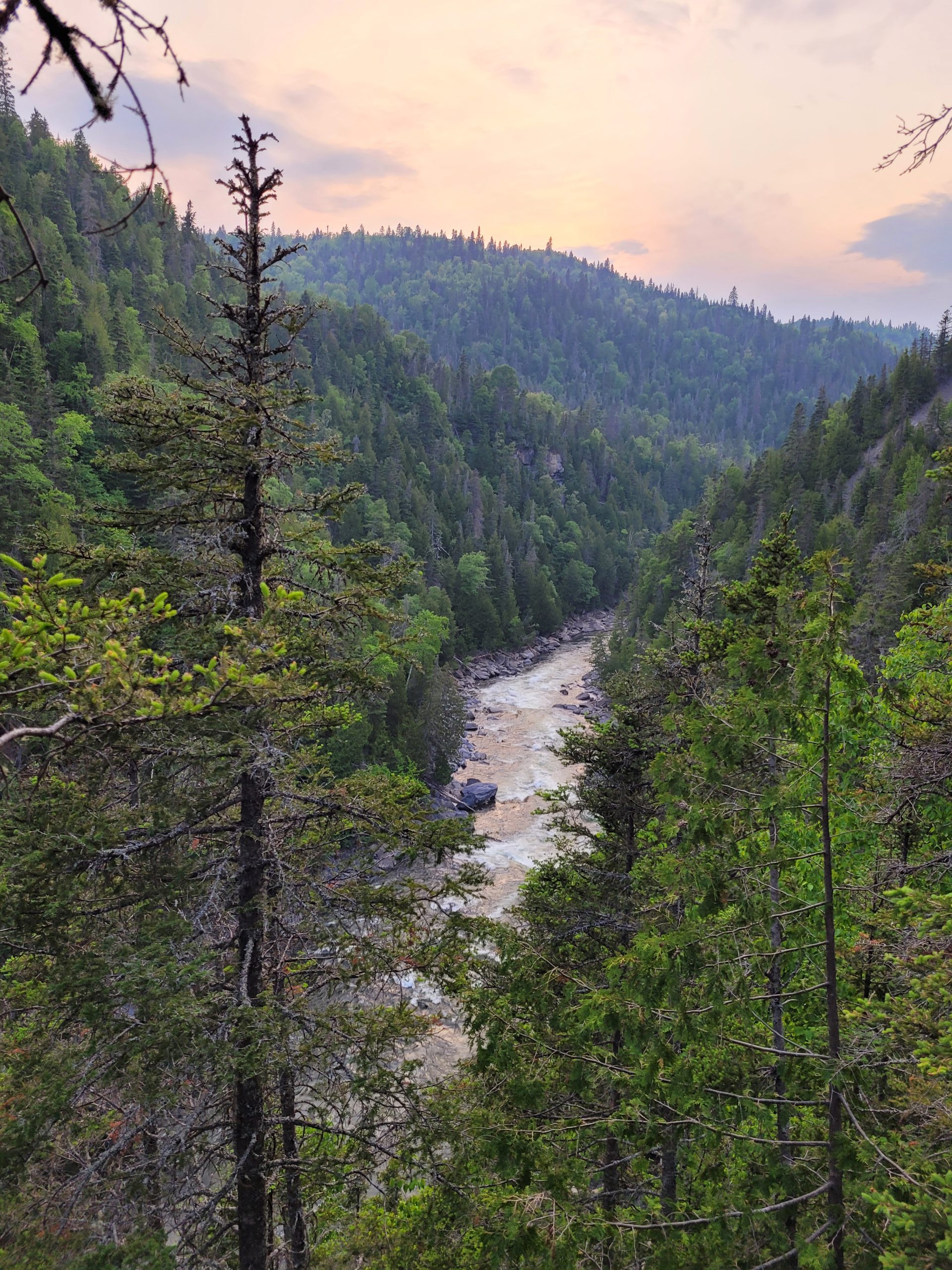
ASF’s Nova Scotia Program Director, Deirdre Green, starts this week with some insight into graduate research work being done on our rivers this summer:
“Science on the Salmon Rivers
If you’re walking the banks of the Margaree, the St. Mary’s, or other rivers across Nova Scotia and New Brunswick this season, keep an eye out for a few fly anglers working with an unusual handheld device. That’s Aaron Krick and his research team from the University of New Brunswick, using a Fish Fatmeter—a non-invasive tool that uses microwave technology to estimate the lipid, or fat, content of returning wild Atlantic salmon.
Sampling is fast—typically under 30 seconds—and follows strict best-practice fish handling protocols. Fish remain submerged throughout the process to reduce stress. The device is simply pressed to the side of the fish, with no penetration or harm caused.
This fieldwork is part of Aaron’s graduate research, conducted in partnership with the Department of Fisheries and Oceans (DFO) and in collaboration with the Ocean Tracking Network (OTN). By handling each fish only once, Aaron and OTN researcher Josh Roland can collect data for both of their complementary projects. Aaron is measuring the salmon’s energy reserves to understand survival and spawning success, while Josh’s team is tracking fish movements throughout the Margaree Watershed through radio telemetry as part of a broader migration study.
Josh’s research aims to identify critical spawning habitats, evaluate the productivity of protected areas, and address key knowledge gaps related to salmon freshwater migration. In parallel with the salmon tracking, Josh is also collaborating with Madelyn Richardson, a researcher at Dalhousie University, who is tracking brown trout to investigate potential overlaps in spawning activity between Atlantic salmon and brown trout in the Margaree Watershed.
Together, Aaron and Josh’s efforts are offering fresh insight into how changing marine and freshwater conditions impact salmon during their return migrations.
If you see Aaron, Josh, or their teams on the riverbank this season, don’t hesitate to say hello. They’re always happy to chat with anglers, learn from local knowledge, and share what they’re seeing from the science side.
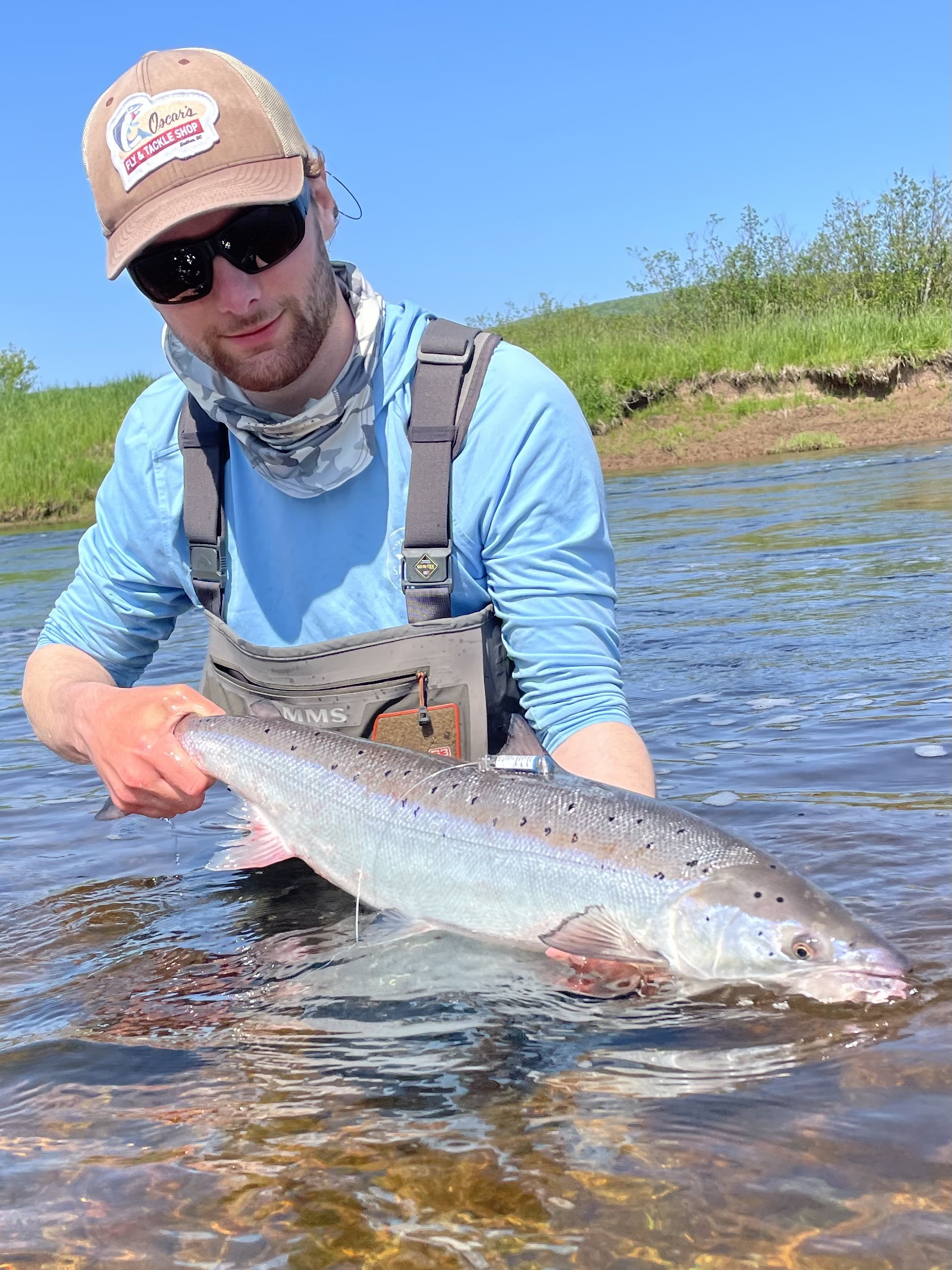
Deirdre also has a report on the early season conditions on some rivers, including the first salmon caught on the Margaree River. There is also a report from a research workshop that shared interesting results that were years in the making. Deirdre writes:
“Early Signs of the Season
The first salmon of the season arrived on the Margaree River over the weekend. According to local guide Robert Chiasson, a handful of fish have been hooked—mostly in the lower river—and sightings are increasing daily. Salmon are also turning up in smaller rivers across Cape Breton, a promising sign that the season is kicking into gear.
On the St. Mary’s River, where recreational fishing for Atlantic salmon is currently closed, community sighting reports indicate that salmon are once again returning in encouraging numbers. This underscores the urgent need for a modernized population assessment to ensure management decisions reflect current conditions and capitalize on conservation opportunities.
While flows remain low—but still fishable—rain would be welcome to freshen things up and support further movement. As more fish arrive each day, we remain hopeful that incoming weather systems will give rivers the lift they need.
“Spotlight: Community-Driven Science on the Margaree
The Margaree Aquatic Research Team (MART) recently held its third annual research workshop at the Margaree Salmon Association office—an event that continues to grow in importance as part of a community-rooted approach to science.
Led by Ph.D. candidate Kristen Cyr, the MART project brings together rights holders, stakeholders, scientists, and community members to co-develop research that responds to local concerns and climate change impacts on salmon and their habitats. This year’s workshop marked a major milestone: sharing preliminary results from several years of collaborative work and interpreting those results together to ensure they reflect diverse perspectives and knowledge systems.
Among the highlights were findings from Kristen’s habitat use study, which showed striking overlap between brown trout and Atlantic salmon parr in cold-water refugia. The findings sparked thoughtful discussion around predation, habitat sharing, and management priorities. Workshop participants also worked together to identify optimal receiver placements for tracking smallmouth bass, explored ways to minimize fish disturbance during sampling, and surfaced key themes for future research.
MART’s work has expanded from a single master’s project into a multi-faceted program now supporting two additional master’s students and an honours thesis. With strong representation from organizations such as the Unama’ki Institute of Natural Resources, Eskasoni Fish and Wildlife Commission, Cheticamp River Salmon Association, Atlantic Salmon Federation, DFO, and local groups, these workshops are growing in both reach and impact.
Want to get involved? Reach out to Kristen at cyrk@uwindsor.ca or follow along on Instagram at @margareeaquaticteam.
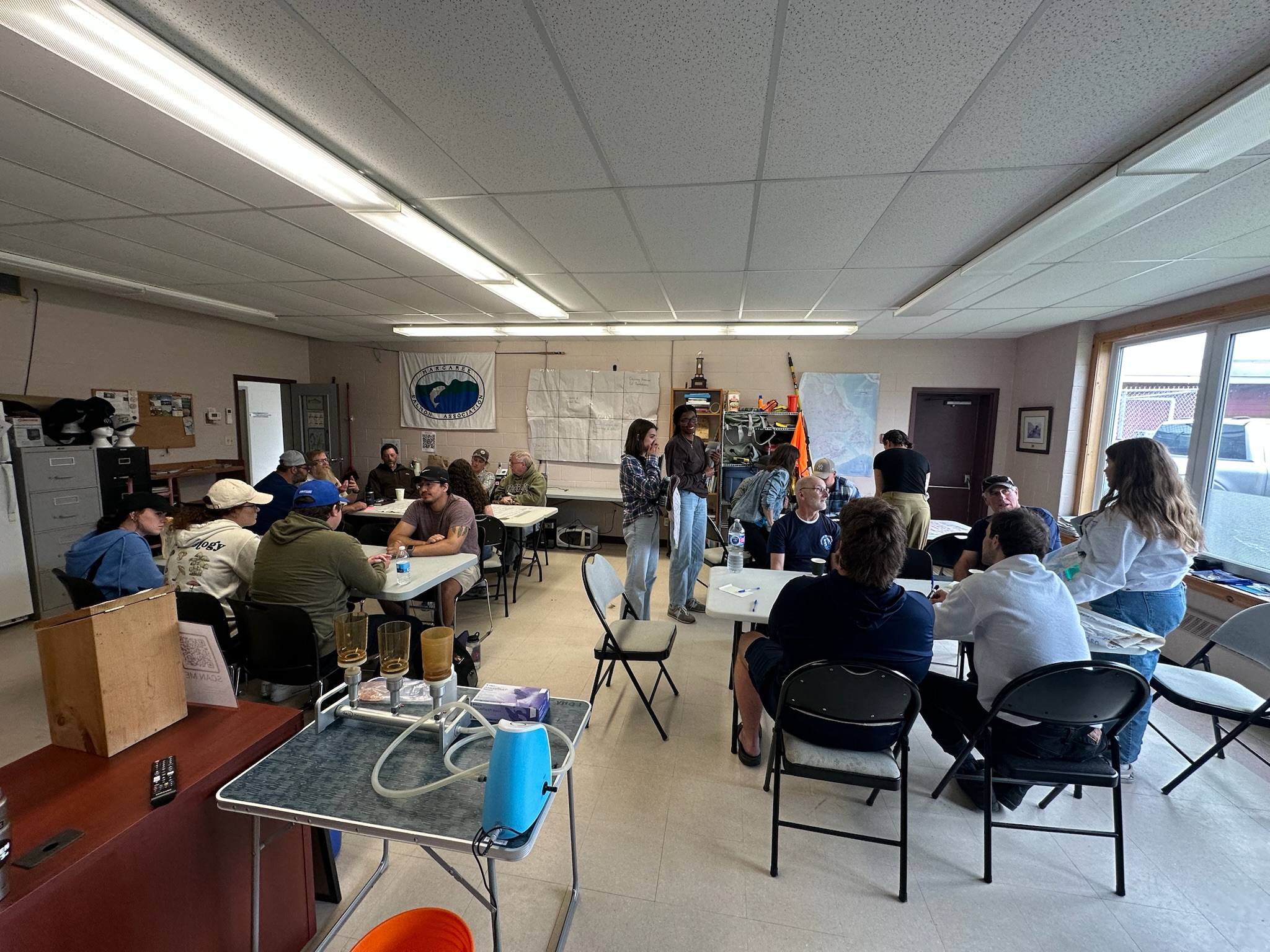
ASF’s research team has been out on the road and in the field. Ellen Mansfield, Office Manager for Research & Environment, writes:
“Teams have completed the tagging portion of the fieldwork and are onto other projects. This includes data input, cleaning gear up for next time, and some well-deserved time off.
This week biologist Graham Chafe is in Halifax for training and licensing with our new drone. He is testing the lower cost field sampling device as well. This new device will be able to take water quality readings such as temperature, pH, and conductivity.”
Graham Chafe, ASF’s Senior Biologist writes:
“ASF Environmental Geographer Aaron Clausen and I were in Halifax this week for Advanced Remotely Piloted Aircraft licenses. We spent a day going over and testing protocols and procedures with the examiner as well as finishing the test for the Restricted Radio Operator – Aeronautic certificate that is also required from drones that weigh over 250g.
The second day involved a flight test where procedures were tested in action and certain maneuvers needed to be performed with the drone. With this license, we can now fly the ASF Research drone in more conditions and use it to complete thermal surveys of river sections as well as scouting locations for other sampling or equipment installation.”
Valerie Ouellet, ASF’s Vice President of Research and Environment, was in Maine. She writes:
“While in the field in Maine, we’ve been seeing great occupants of the woods. We had the pleasure of seeing this young buck two weeks ago. Always nice to nice healthy-looking moose.”
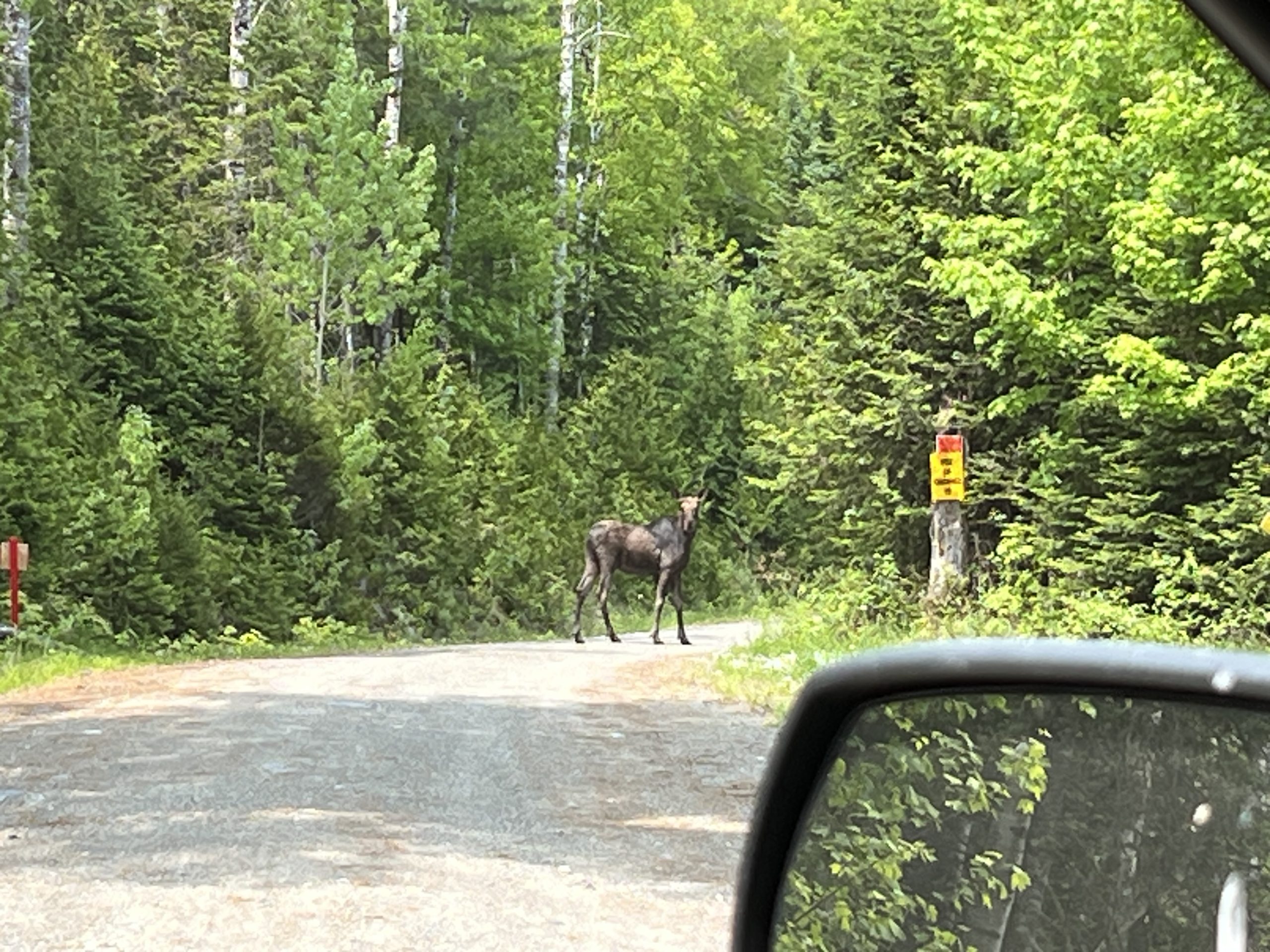
Valerie continues:
“Last week we also held a second Thermal Imagery Workshop in Maine, talking more about applications of the technology and useful tools for analyzing the data. We will start having the workshop series in Canada too, starting in August. Stay tuned for more details coming soon.”
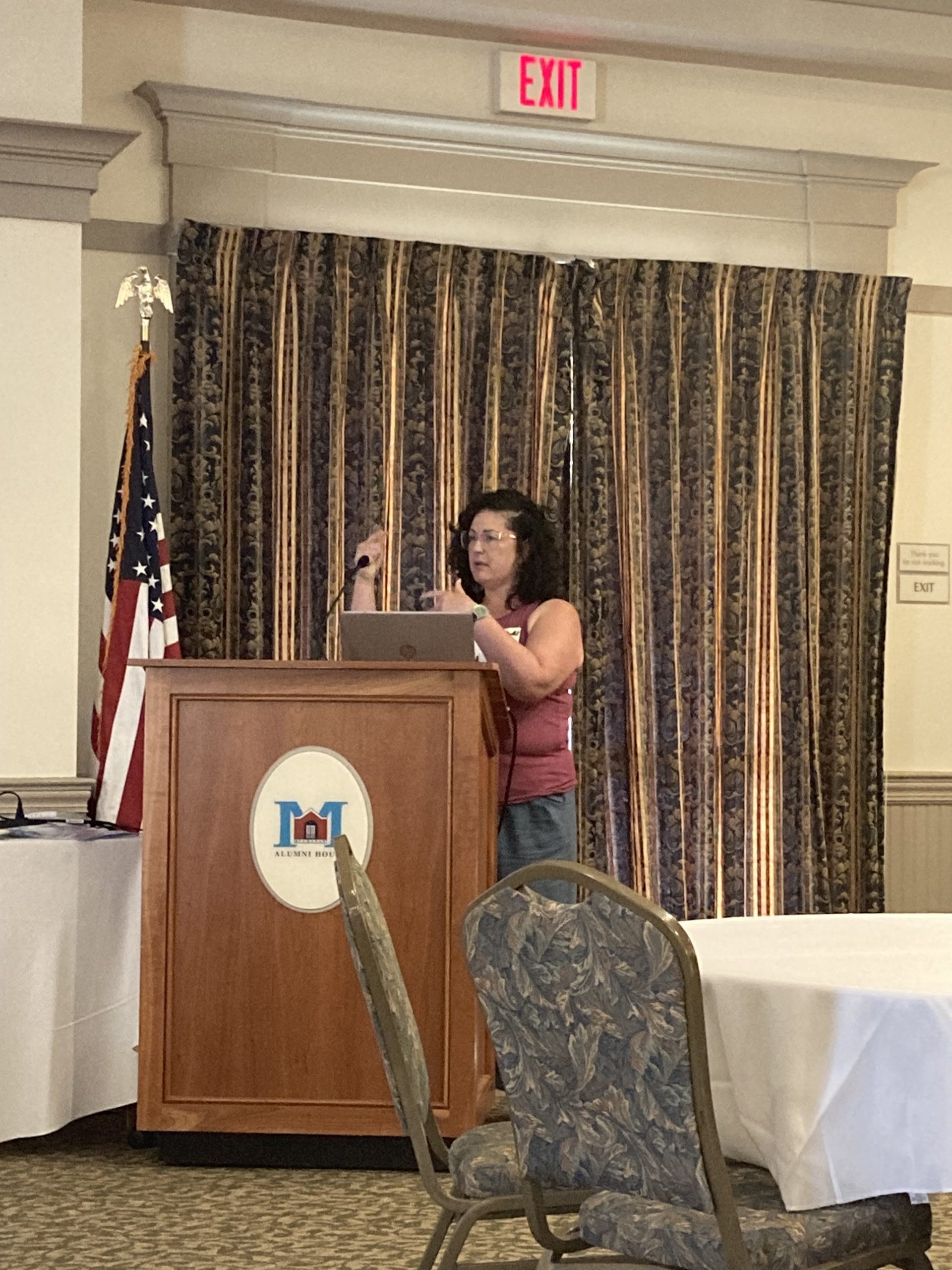
Heather Perry, ASF’s Biologist / Research Scientist, was also in the field doing radio tagging in some study areas. She writes:
“We electro-fished again yesterday (June 16) and caught all kinds of parr and brook trout. However, they are still fairly small and we are looking for the biggest of the cohort to carry radio tags. It is early and has been a relatively cooler spring, at least compared to last year. The brooks are just reaching optimal growing temps for parr (between 16-19°C) so we hope to find more of taggable sizes as we continue e-fishing in the coming weeks. We’re up to 18 tagged parr and have tracked them all not far from where they were released.
The study (radio tagging) consists of 16 stationary receivers placed about 1 km apart with upstream and downstream pointed antennas to monitor fish movement throughout the ~20 km reach on the Little Southwest Miramichi. We don’t expect to see much movement while the water remains below 24°C, apart from re-establishing territories after tagging. Our main objective is to monitor their movement when temperatures exceed 24°C and they must begin to seek refuge in cold water anomalies (areas where the water is cooler than the occurring mainstem temperatures).”

